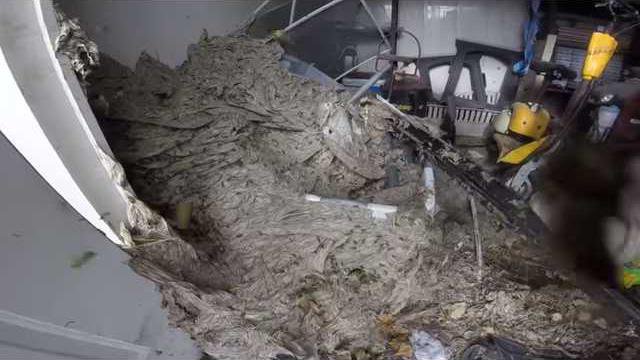THE SHED I remember the first time I got stung by a bee.
I was 6 or 7 years old and I was rolling down the hill across from my house when I felt a really intense pinch in my arm. I stopped in my grass trodden tracks to see that I'd squashed a bee with my tiny bicep (which is approximately when the screaming started).
The second time I got stung, I was picking up a bag only to feel what I figured was a needle penetrating my middle finger. Turns out, a wasp had nestled into the fabric handles and gotten me right in the digit, which ended up swelling to an uncomfortable size.
With a good decade or so between me and the memory of having a stinger stuck in my skin, watching the internet's latest viral video still made me squeamish (and itchy).
The YouTube account Stinger Creations released a video yesterday that shows a GoPro's view of a wasp nest removal, only this is no volleyball-sized nest. It's a sprawling, shed-filling, "here's a motorized scooter for size reference" looking monstrosity.
In the video, we see a survey of the nest, some points of reference for size differentiation and so, so many swarming, buzzing wasps around this man who doesn't seem too bothered by the idea of entering into a confined space full of potentially stingy doom. I've seen "My Girl." I know how this story ends.
But Stinger Creations obviously knows what he's doing, as evidenced by his previous uploads, "Bee Swarm Season" and "Bee removal with bare hands."
Personally, I'm glad heroes like this are out there.
I was 6 or 7 years old and I was rolling down the hill across from my house when I felt a really intense pinch in my arm. I stopped in my grass trodden tracks to see that I'd squashed a bee with my tiny bicep (which is approximately when the screaming started).
The second time I got stung, I was picking up a bag only to feel what I figured was a needle penetrating my middle finger. Turns out, a wasp had nestled into the fabric handles and gotten me right in the digit, which ended up swelling to an uncomfortable size.
With a good decade or so between me and the memory of having a stinger stuck in my skin, watching the internet's latest viral video still made me squeamish (and itchy).
The YouTube account Stinger Creations released a video yesterday that shows a GoPro's view of a wasp nest removal, only this is no volleyball-sized nest. It's a sprawling, shed-filling, "here's a motorized scooter for size reference" looking monstrosity.
In the video, we see a survey of the nest, some points of reference for size differentiation and so, so many swarming, buzzing wasps around this man who doesn't seem too bothered by the idea of entering into a confined space full of potentially stingy doom. I've seen "My Girl." I know how this story ends.
But Stinger Creations obviously knows what he's doing, as evidenced by his previous uploads, "Bee Swarm Season" and "Bee removal with bare hands."
Personally, I'm glad heroes like this are out there.








